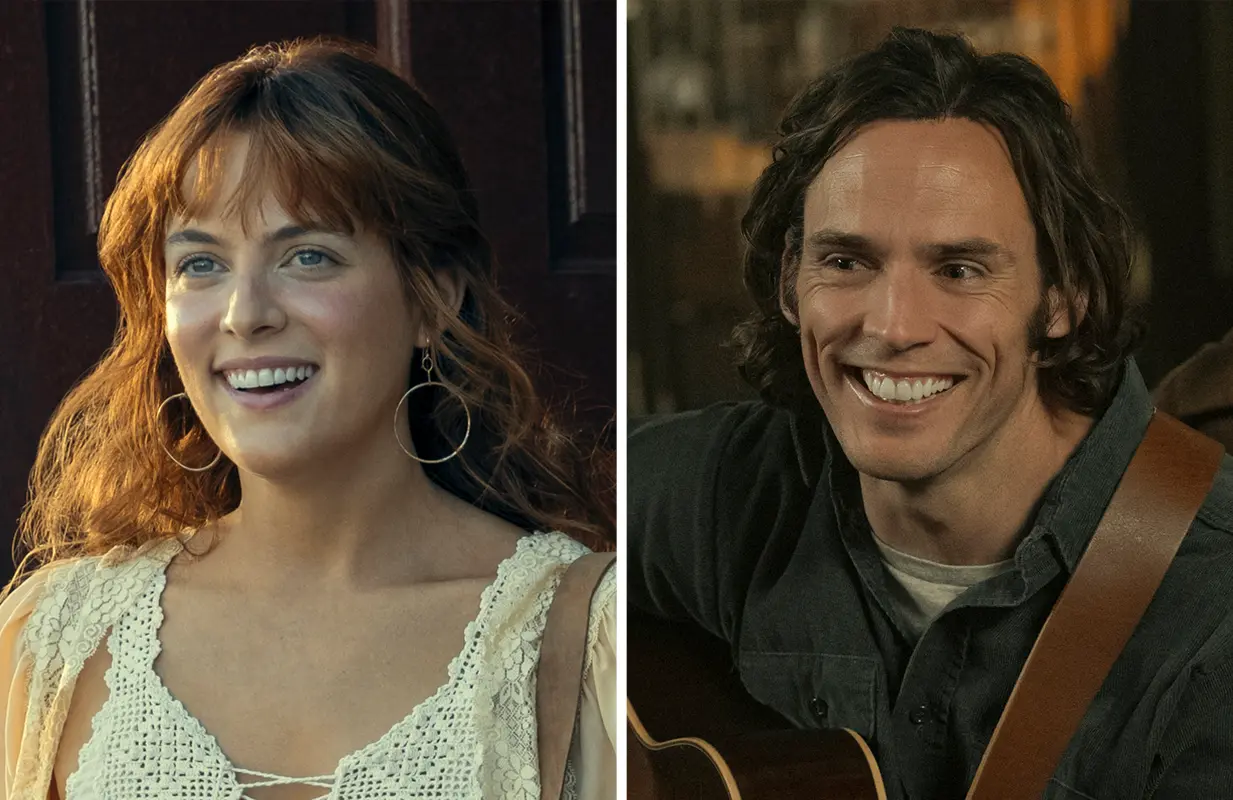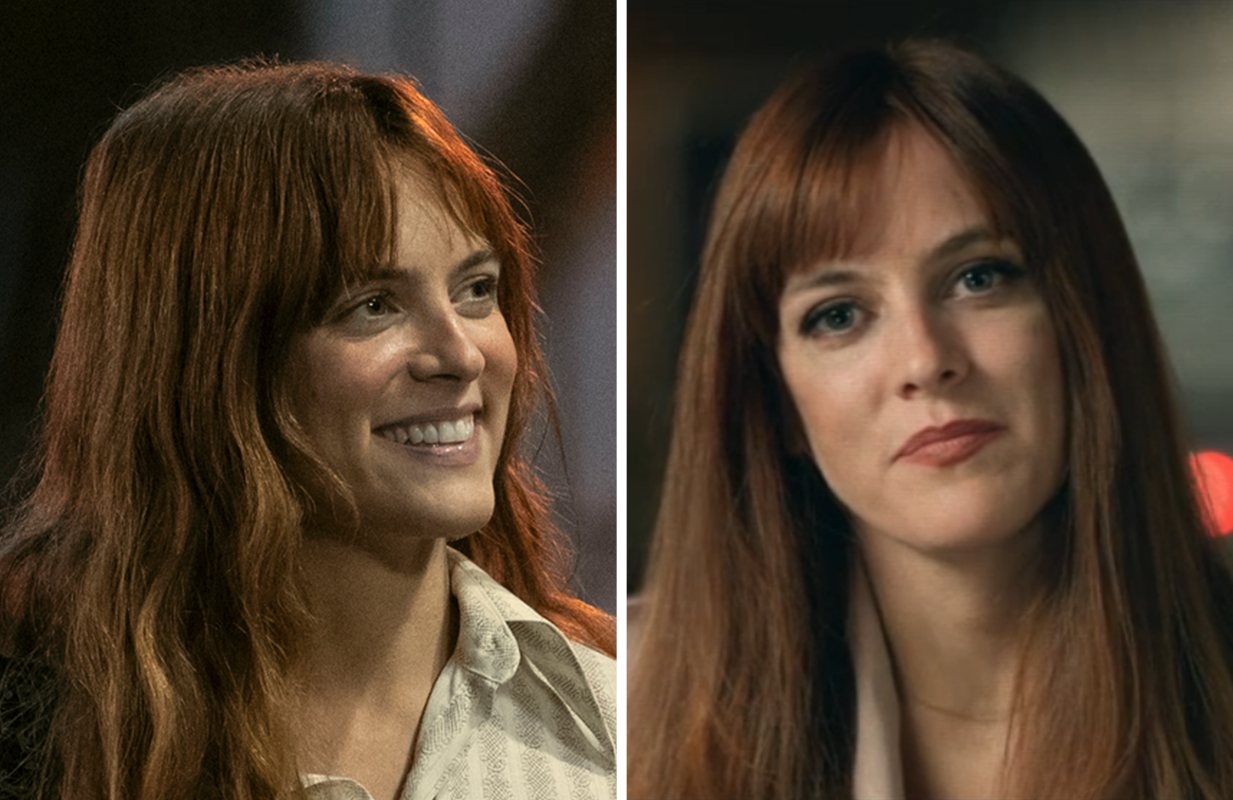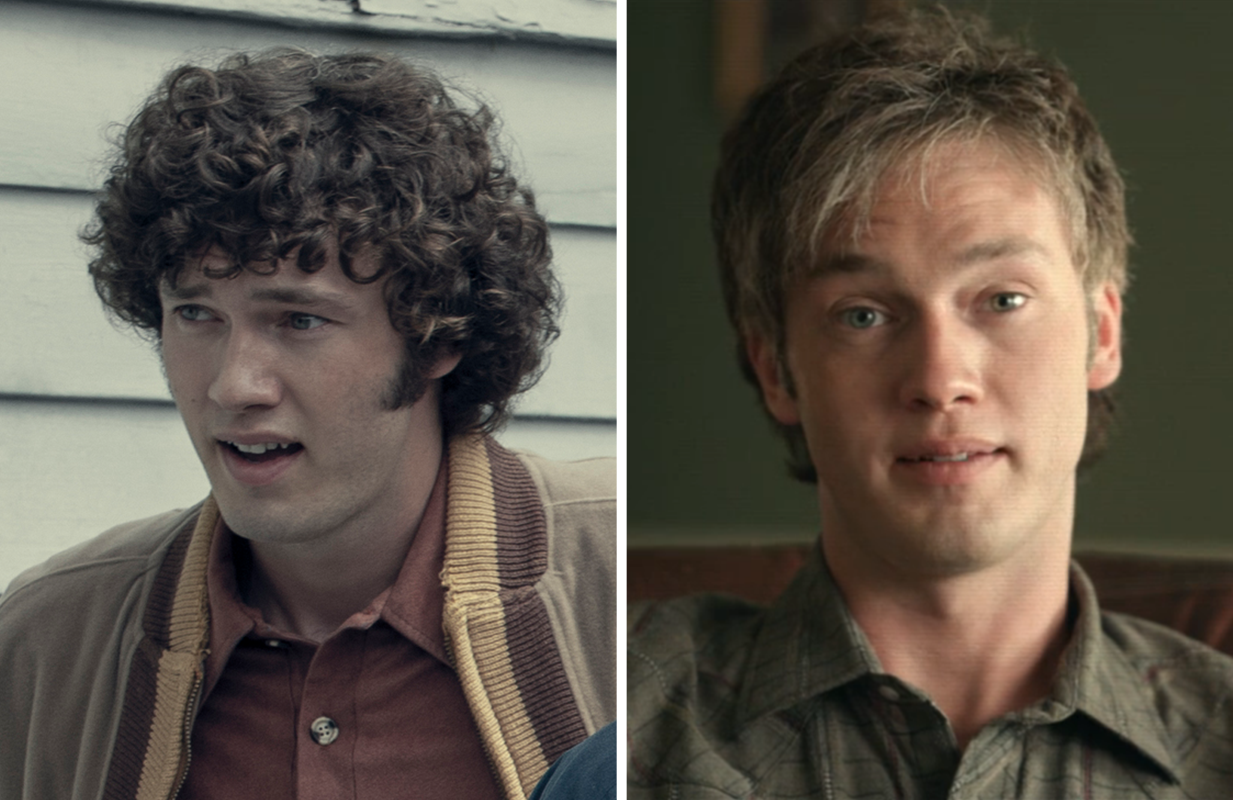Daisy Jones & The Six's 'Subtle' Aging Strikes a Discordant Note
-
 Riley Keough and Sam Claflin in Daisy Jones & The Six (Photos: Lacey Terrell/Prime Video)
Riley Keough and Sam Claflin in Daisy Jones & The Six (Photos: Lacey Terrell/Prime Video)Maybe it’s the free-flowing drugs of the era, but time seems to move differently in Daisy Jones & The Six.
The limited series, which is based on the bestselling novel by Taylor Jenkins Reid, chronicles the rise of a fictional band and the confluence of events that led to the group’s sudden downfall, as remembered by its members 20 years later. These kinds of framing devices are common in the rock biopic genre, but typically, viewers are given a visual indication of how much time has passed between the flashbacks that fuel the drama and the more contemporary footage that bookends them. That isn’t the case with Daisy Jones, which ages Daisy (Riley Keough), Billy (Sam Claflin), and the rest of the characters up and down with so little consistency that it’s difficult to tell how old anyone is, or where we are in the timeline of events, at any given moment.
Take the first episode, “Track 1: Come and Get It,” which introduces age-appropriate versions of the teenage characters. In 1968, a wide-eyed, 15-year-old Daisy (Amanda Fix) realizes that the Los Angeles music scene offers an escape from her miserable home life; across the country, Pittsburgh heartthrob Billy (Dan Roe) takes his 14-year-old brother Graham (Sloane Letourneau) and his friends under his wing, forming a band known as The Dunne Brothers. These actors are fresh-faced and suitably gangly, but when we see them again two years, and 10 minutes of screen time, later, they’ve aged up considerably. Their childlike awkwardness has been replaced by the confidence of Daisy Jones’ adult stars, almost all of whom are in their 30s (the exceptions being Will Harrison as Graham and Camila Morrone, whose relationship with Leonardo DiCaprio famously ended shortly after she turned 25, as Billy’s wife Camila). This is more than just puberty or a two-year growth spurt: It’s full-blown adulthood, right down to the crow’s feet and forehead wrinkles.
The jarring transition to a new, adult cast could be forgiven — or at the very least overlooked — if Daisy Jones & The Six continued to age its characters apace. As the show moves from 1970 to 1977, Billy and Daisy’s excessive drug and alcohol use catches up to them, but though the 36-year-old Claflin transforms into a haggard rock star almost overnight, it takes a few years for signs of wear and tear to appear on Keough. Meanwhile, the supporting bandmembers remain frozen in time, despite doing just as much partying as their lead singer-songwriters.
But nowhere are Daisy Jones’ aging inconsistencies more apparent than in the flash-forward interview scenes, which are set in the late 1990s. If Claflin looks at his oldest in the ’70s-set flashbacks, he appears to have de-aged in the 20 years since. Billy’s unruly curls have been professionally straightened into a luscious mane, his beard remains free of gray, and his once-prominent laugh lines and wrinkles have been smoothed out. Daisy also seems to have gotten the Benjamin Button treatment: Though her face is fuller, her skin is blemish-free, and like Billy’s, shows no signs of a rock ’n’ roll past. Daisy Jones suggests Billy and Daisy are vain enough to have gotten work done in the two decades since that final show, but unless their Botox treatments came with a time machine, it strains credulity to believe that they would look this good all these years later.

When it comes to the other bandmembers, the full spectrum of aging is on display, their varied looks making up a rainbow of graying hair and pallid complexions. The years have been kindest to The Six keyboardist Karen (Suki Waterhouse), guitarist-turned-bassist Eddie (Josh Whitehouse), and Daisy’s friend Simone (Nabiyah Be), who have clearly matured, but have maintained a bit of a youthful glow into their 40s. For his part, Warren (Sebastian Chacon), the band’s drummer, has developed deep lines in his forehead and around his mouth. And then there’s Graham, who has gone fully gray, but seems to have avoided any other markers of aging. Together, Harrison’s gray wig and his naturally smooth skin make his character look simultaneously 15 years older than the rest of the group and 15 years younger, a visual contradiction that I just couldn’t shake.
So, what exactly is going on with Daisy Jones & The Six’s de- and re-aging process? For weeks, I was consumed by this question, and finally, I decided to go straight to the source: makeup department head Rebecca Wachtel. Wachtel explains she tested everything from heavy aging makeup to prosthetics, but ultimately, the production team decided to go a more “subtle” route, especially because the show’s interview scenes only take place 20 years after the band’s final performance. (In the book, these interviews are conducted 40 years after the fact.)
“[Producers] didn’t want to age them to the extent of the book; they just wanted to age them a little,” she says of the flash-forward scenes. “So I did subtle ager. I did some ager which changes the texture of the skin and adds wrinkles, but it’s very light.”
When asked why Billy and Daisy look younger in the 1990s-set scenes, Wachtel points to their heavy drug use in the ’70s. “The early episodes, for Billy, were really more about his journey of addiction, and then he comes out of it. So he is intentionally looking worse because of that,” she tells me. “Daisy is doing drugs, but we don’t really see it on her when she’s younger, because when you’re young it doesn’t show as much. So in later episodes, you’ll start to see a shift in her skin tone being more washed out, and dark circles and redness [appear].”
Of course, “these are still rock stars,” says Wachtel, and it’s likely that some have made an effort to combat any visible signs of aging. (She specifically mentions Karen as a candidate for cosmetic work.) Furthermore, these characters are “only in their mid-40s,” and “everybody ages differently,” even brothers like Billy and Graham: “One of them could’ve just had a different gene where one of them grayed, and the other didn’t.”

“Some people age more than others, so I wanted to take that into account,” she says. “Daisy, she has little lines and deeper-set eyes, and she’s shifted her aesthetic, but she’s aged well. Warren, maybe it was a little rougher for him. [Wachtel’s team gave Warren a prosthetic double chin, on top of the aging makeup.] And Graham always had a baby face — sometimes people just keep that aesthetic throughout their life, even though you can see gravity is taking control and things are starting to shift.”
Wachtel says the show’s subtle aging is meant to walk “a fine line of not being distracting and being believable,” but even with this in mind, it still feels like something was lost in translation over the course of production. Any show or movie requires us to suspend our disbelief, to a certain extent (how else do you explain movie stars playing regular-looking people?), but what Daisy Jones asks of its audience goes above and beyond. Perhaps we could chalk up the mismatch between the characters’ appearance and supposed age in the flashbacks as unreliable narration: These scenes are being offered up by the bandmembers as they prefer to remember them, and if that means eliminating any lingering signs of childhood, so be it. But Daisy Jones presents its ’90s-set interviews as objective fact, giving us something concrete to hold on to as the narration gets fuzzy. If we’re truly dealing in the world of reality, there’s no way to reconcile the visual discrepancies across these scenes with what we’ve been told about these characters. As a result, the show’s haphazard aging process takes viewers out of the scene at the exact moment when they should be preparing for the greatest emotional punch.
Ultimately, a post-production decision may be responsible for Daisy Jones & The Six’s uncanny look. “I did add a lot more [makeup] on them, but the way they shot it and did post, it kind of washed a lot of things out,” explains Wachtel. “I think it was a choice in post with the aesthetic of what the documentary series would look like. That probably affected it, as well.”
“Being a makeup artist, you do what you think looks right and works in the time that you’re doing it,” she says. “You’re watching the monitor, but then you don’t know what’s going to happen after that. So, I don’t have any control after that point.”
New episodes of Daisy Jones & The Six drop every Friday on Amazon Prime Video through March 24. Join the discussion about the show in our forums.
Claire Spellberg Lustig is the Senior Editor at Primetimer and a scholar of The View. Follow her on Twitter at @c_spellberg.
TOPICS: Daisy Jones & The Six, Prime Video, Josh Whitehouse, Nabiyah Be, Riley Keough, Sam Claflin, Sebastian Chacon, Suki Waterhouse, Taylor Jenkins Reid, Will Harrison